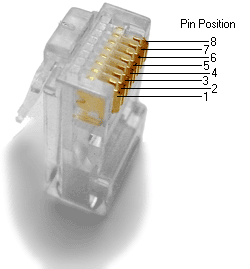
 8 pin RJ45 (8P8C) female connector at the
network interface cards/hubs.
8 pin RJ45 (8P8C) female connector at the
network interface cards/hubs.
 8 pin RJ45 (8P8C) male connector at the
cables.
8 pin RJ45 (8P8C) male connector at the
cables.
1000BASE-T (also known as IEEE 802.3ab) is a standard for gigabit Ethernet over copper wiring. It requires, at least Category 5 cable (the same as 100BASE-TX), but Category 5e (“Category 5 enhanced”) or Category 6 cable may also be used and are often recommended. 1000BASE-T requires all four pairs to be present and is far less tolerant of poorly installed wiring than 100BASE-TX.
| Pin | Name | Description | TIA/EIA 568A | TIA/EIA 568B |
|---|---|---|---|---|
| 1 | BI_DA+ | Bi-directional pair A+ (tranceive) |  white/green white/green |
 white/orange white/orange |
| 2 | BI_DA- | Bi-directional pair A- (tranceive) |  green green |
 orange orange |
| 3 | BI_DB+ | Bi-directional pair B+ (receive) |  white/orange white/orange |
 white/green white/green |
| 4 | BI_DC+ | Bi-directional pair C+ |  blue blue |
 blue blue |
| 5 | BI_DC- | Bi-directional pair C- |  white/blue white/blue |
 white/blue white/blue |
| 6 | BI_DB- | Bi-directional pair B- (receive) |  orange orange |
 green green |
| 7 | BI_DD+ | Bi-directional pair D+ |  white/brown white/brown |
 white/brown white/brown |
| 8 | BI_DD- | Bi-directional pair D- |  brown brown |
 brown brown |
Notes
- T568A and T568B are the two color codes used for wiring eight-position RJ45 modular plugs. Both are allowed under the ANSI/TIA/EIA wiring standards. The only difference between the two color codes is that the orange and green pairs are interchanged. T568A wiring pattern is recognized as the preferred wiring pattern for this standard because it provides backward compatibility to both one pair and two pair USOC wiring schemes. The T568B standard matches the older ATA&T 258A color code and is/was(?) the most widely used wiring scheme. It is also permitted by the ANSI/TIA/EIA standard, but it provides only a single pair backward compatibility to the USOC wiring scheme. The U.S. Government requires the use of the preferred T568A standard for wiring done under federal contracts.
- Each network segment cable length may be up to 100 meters, although several chip manufacturers claim 150 meters.
- Autonegotiation is a requirement for using 1000BASE-T, according to the standard.
- Several device drivers will allow you to force 1000 Mbps full duplex to eliminate autonegotiation issues.